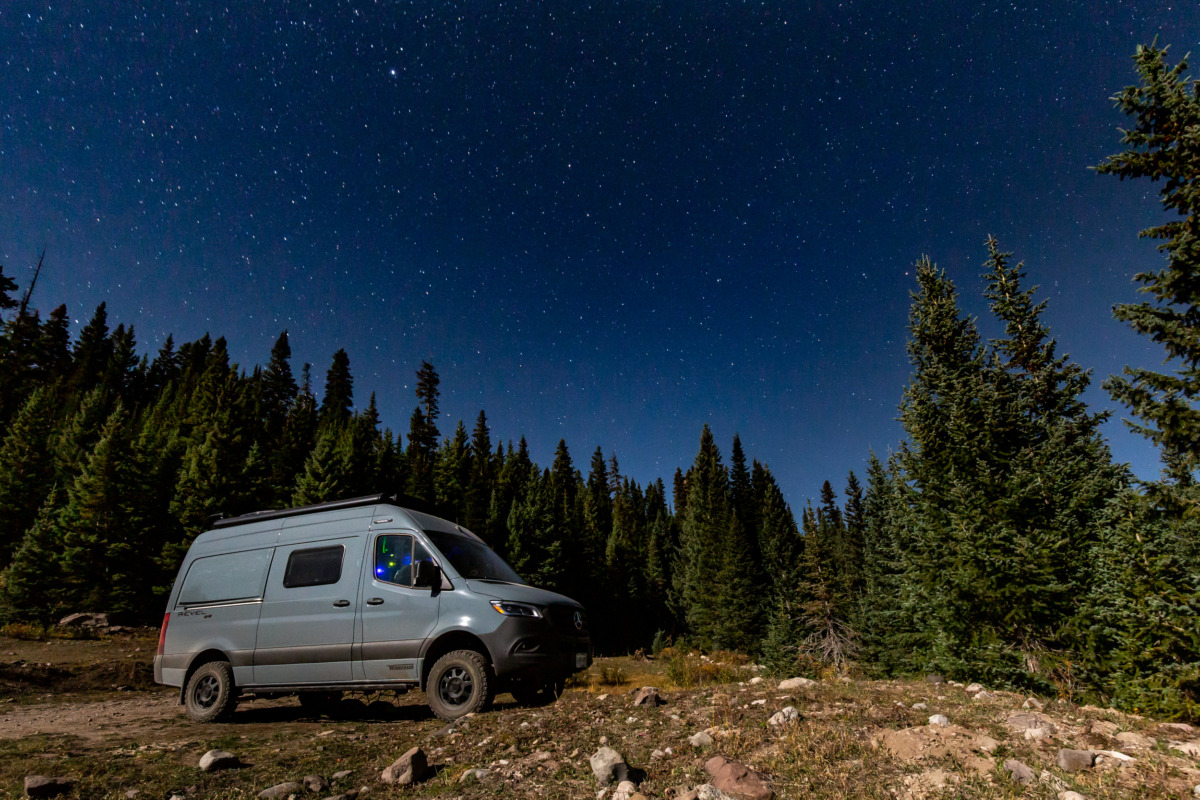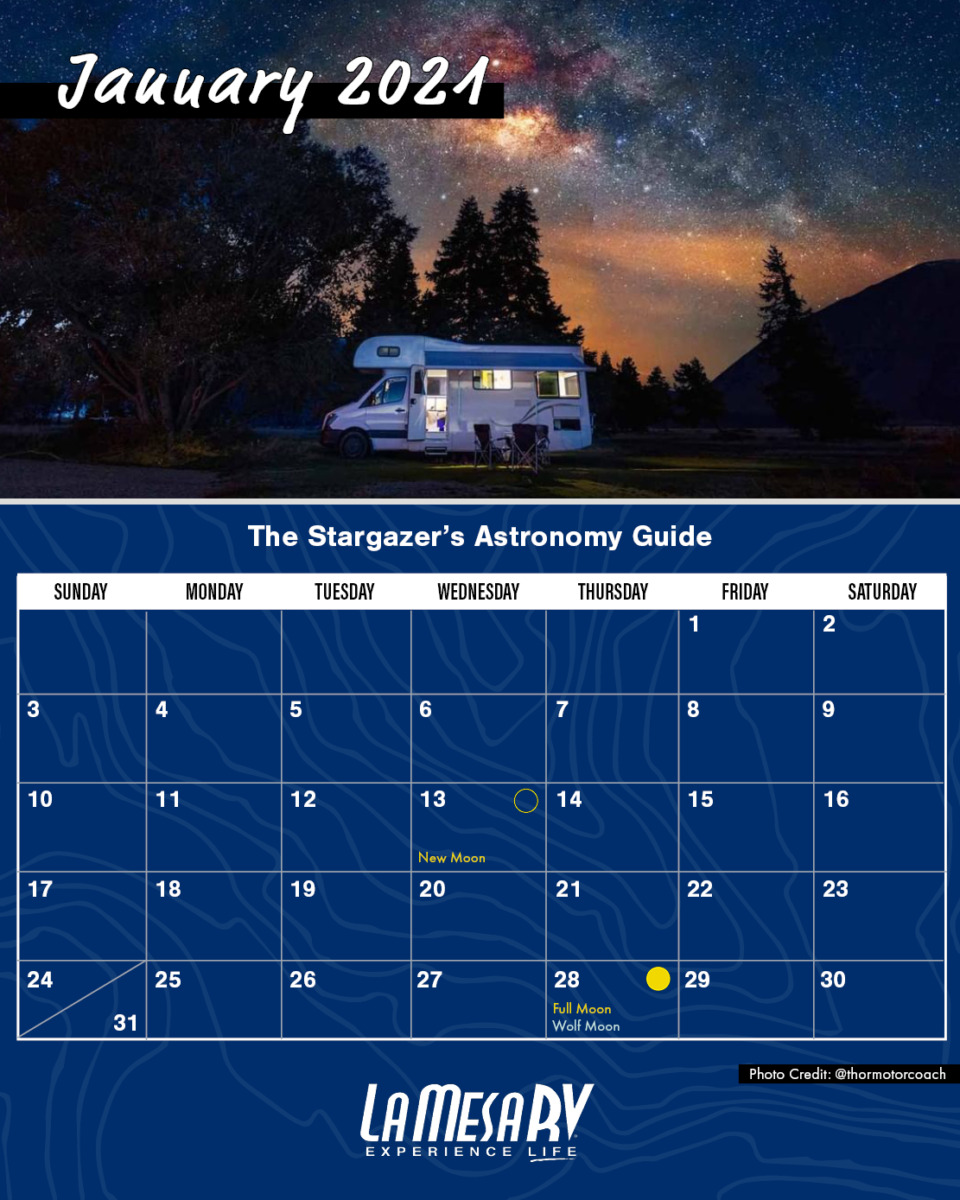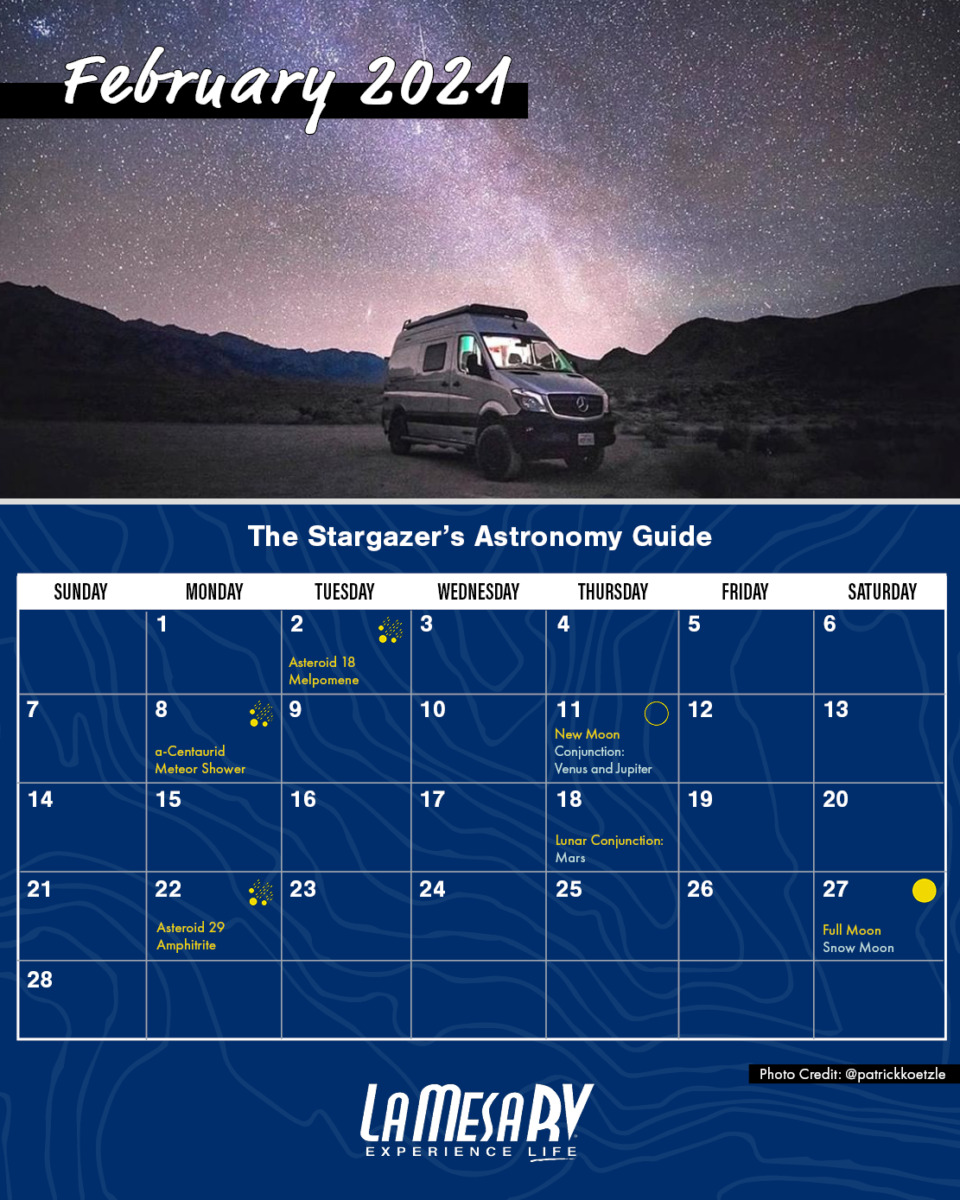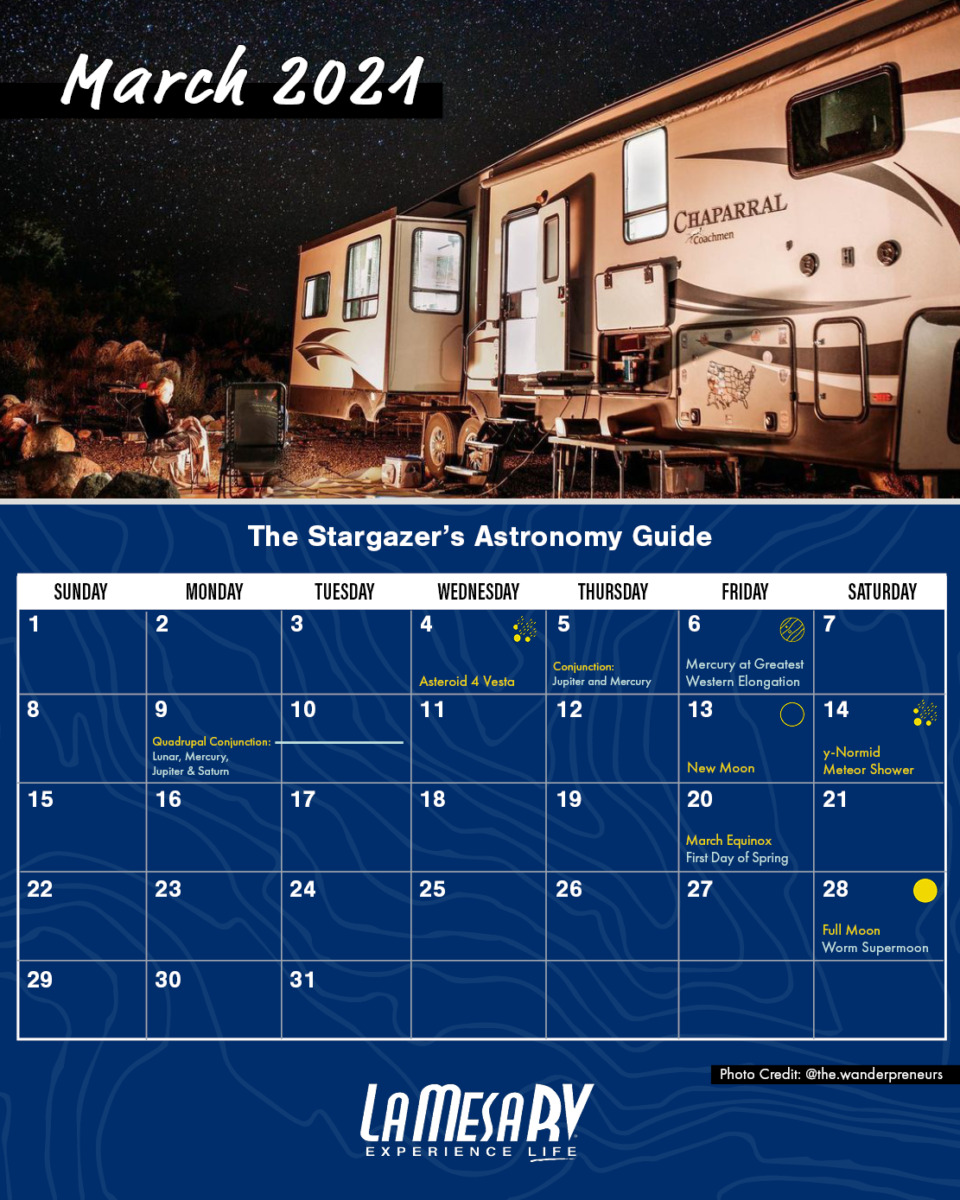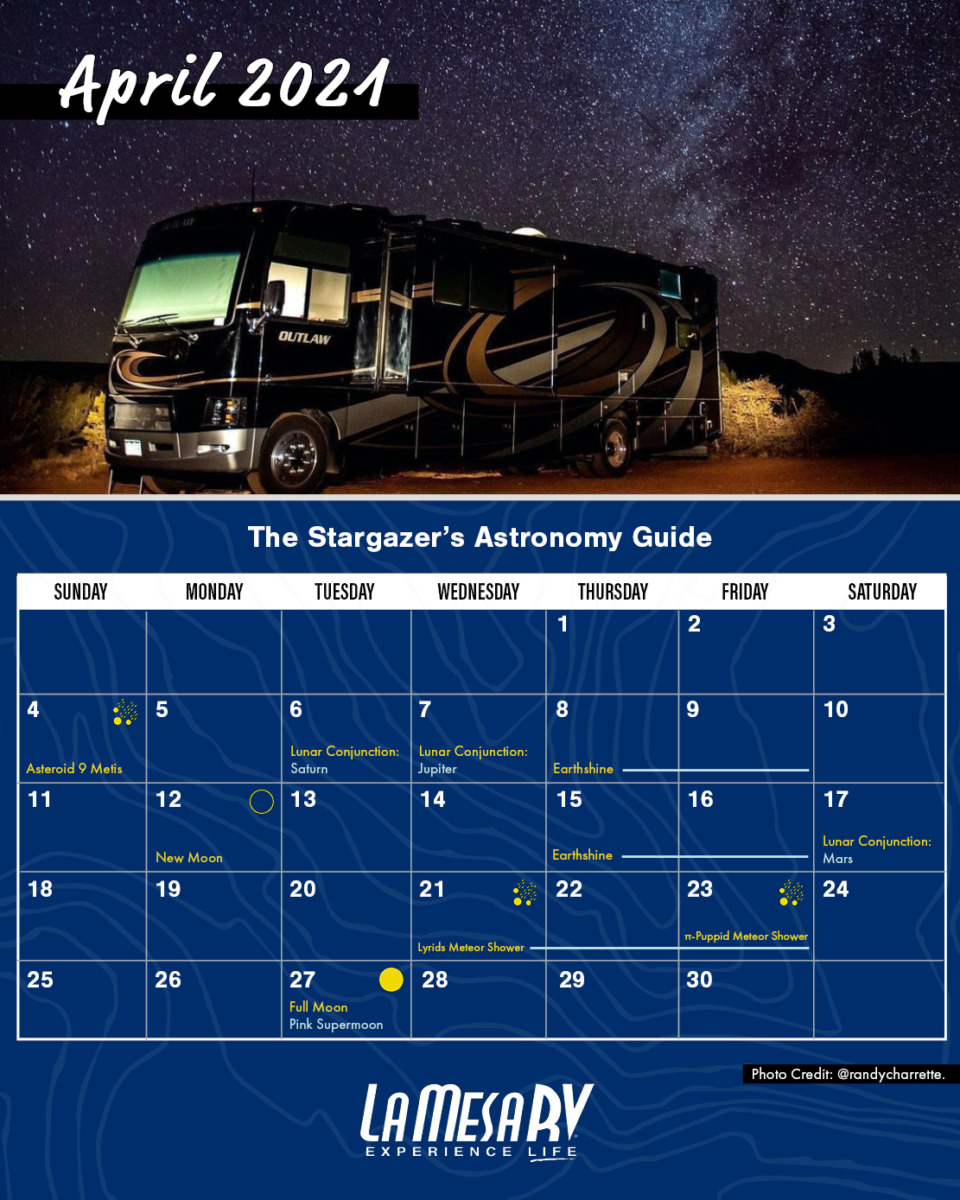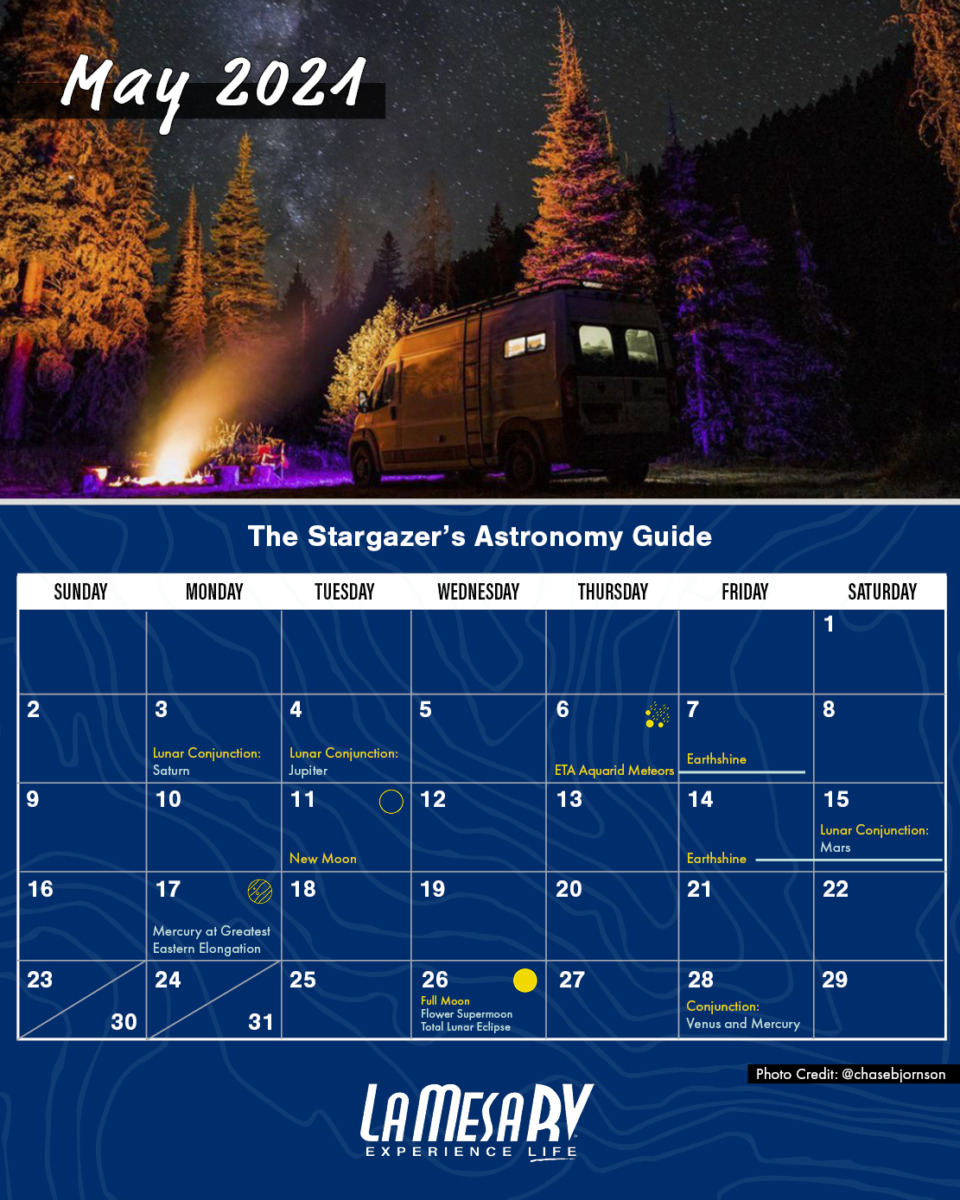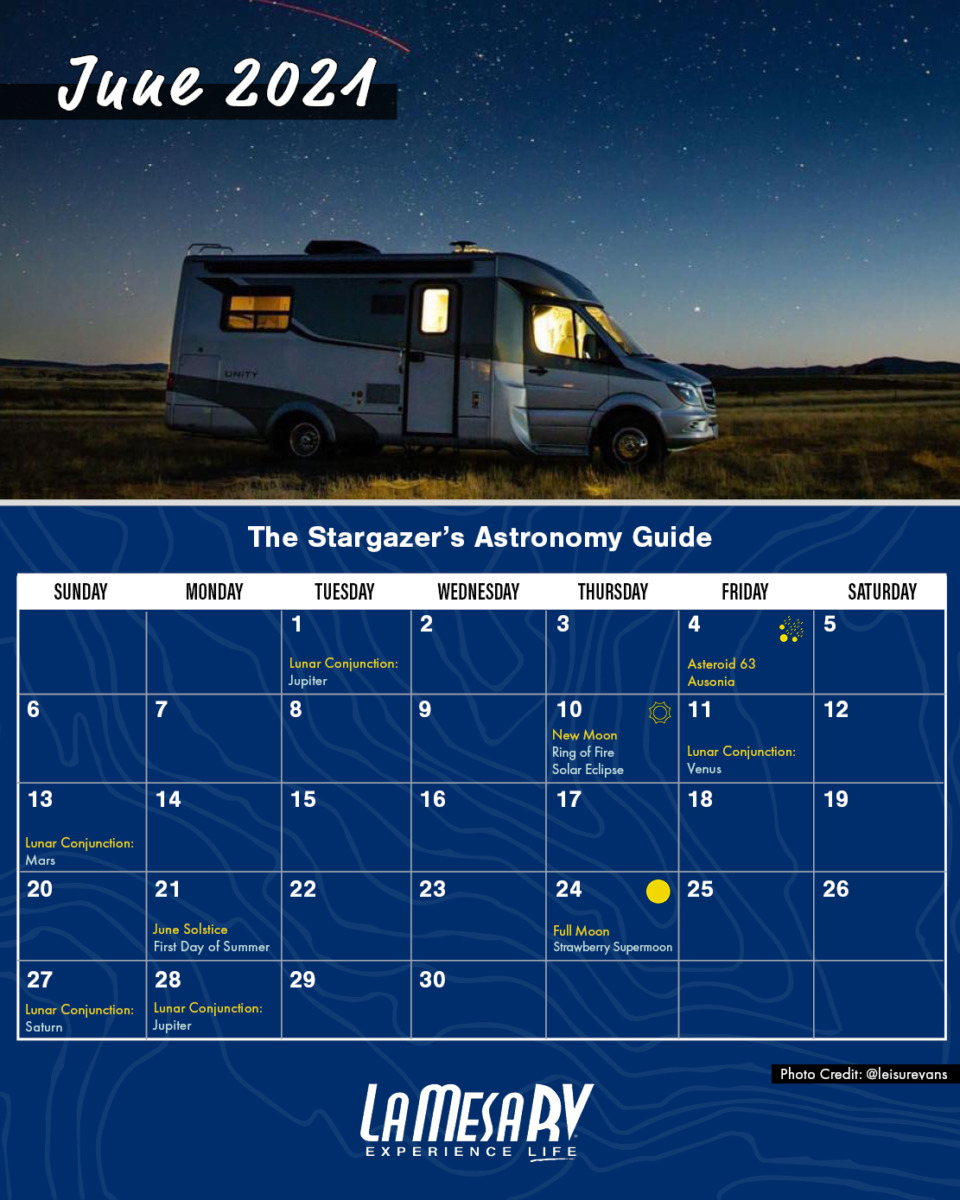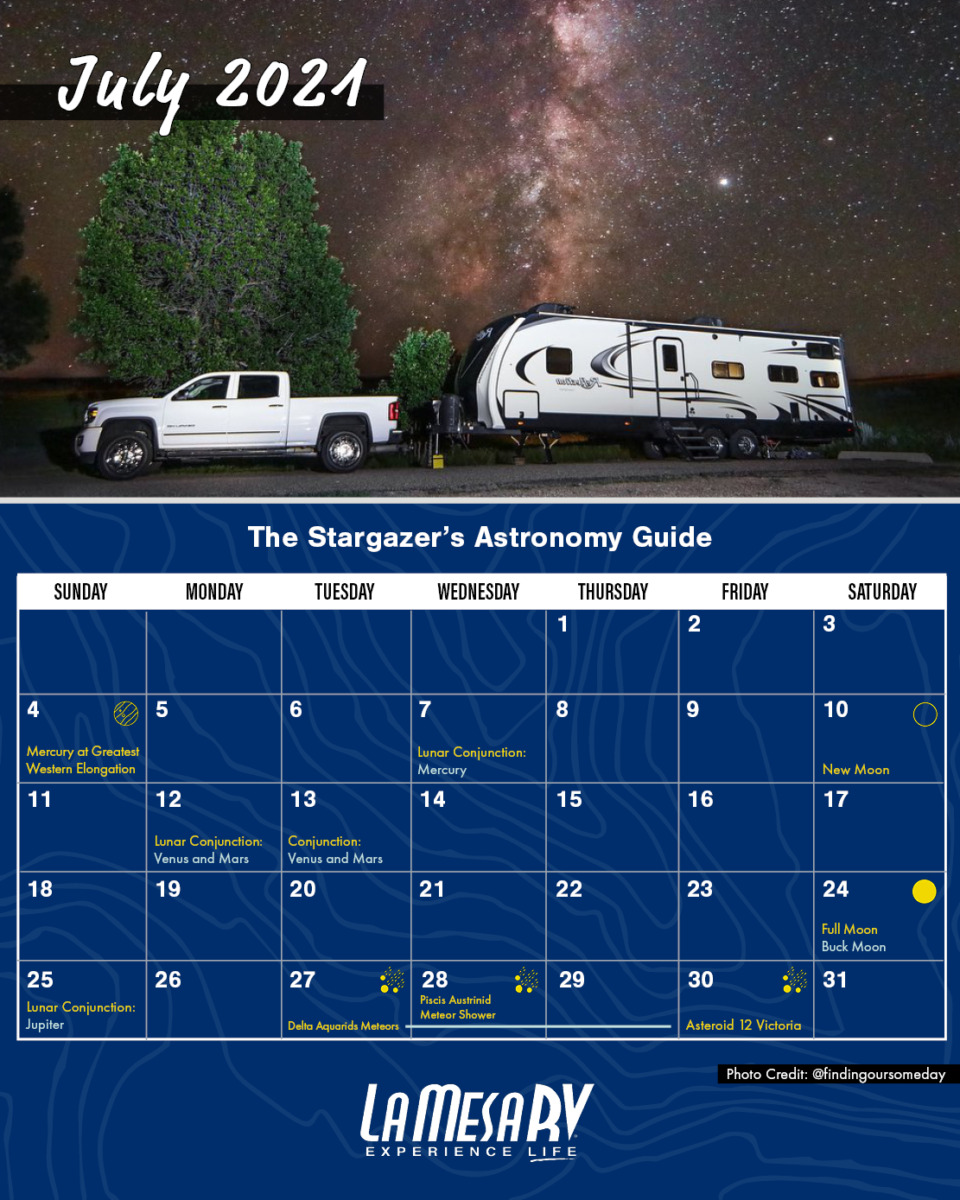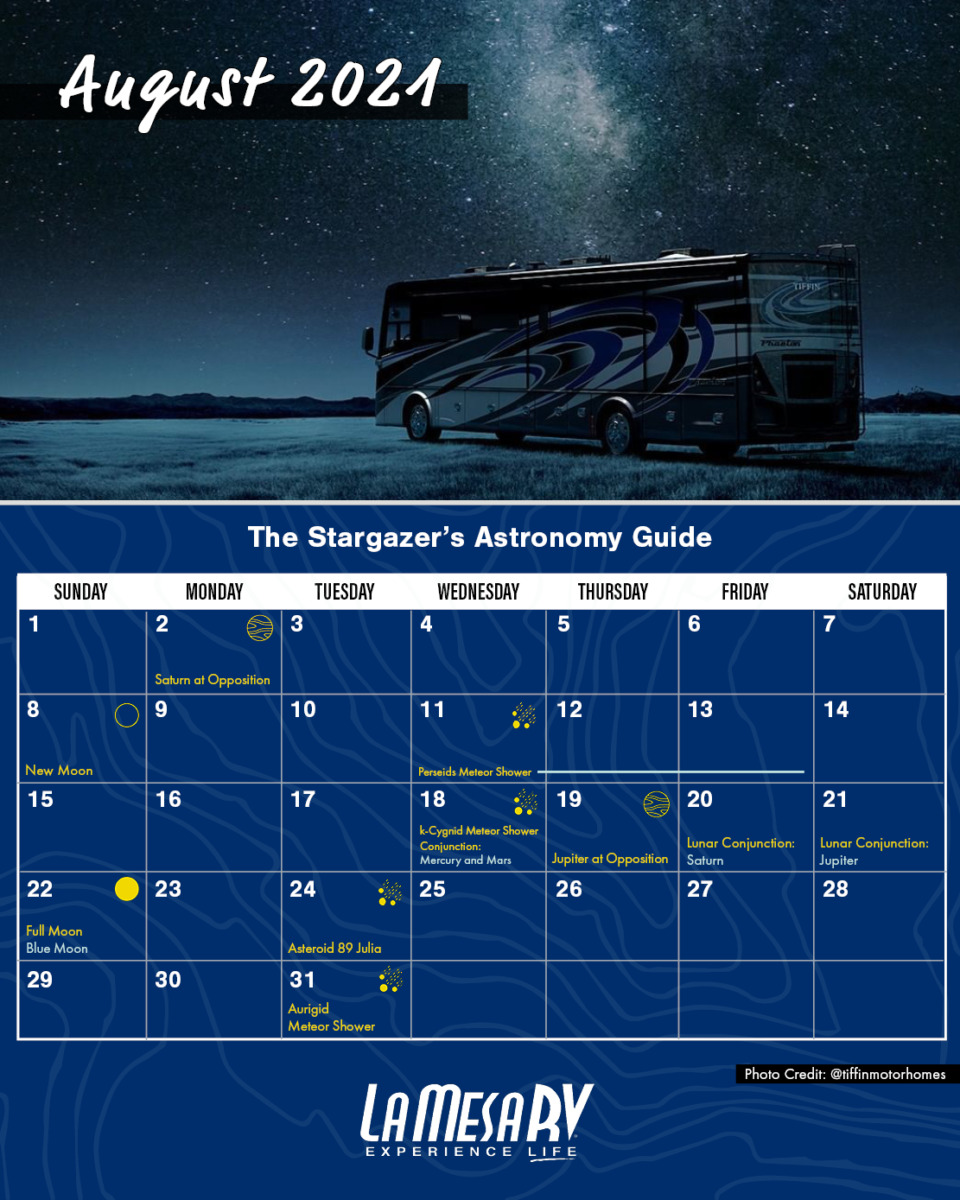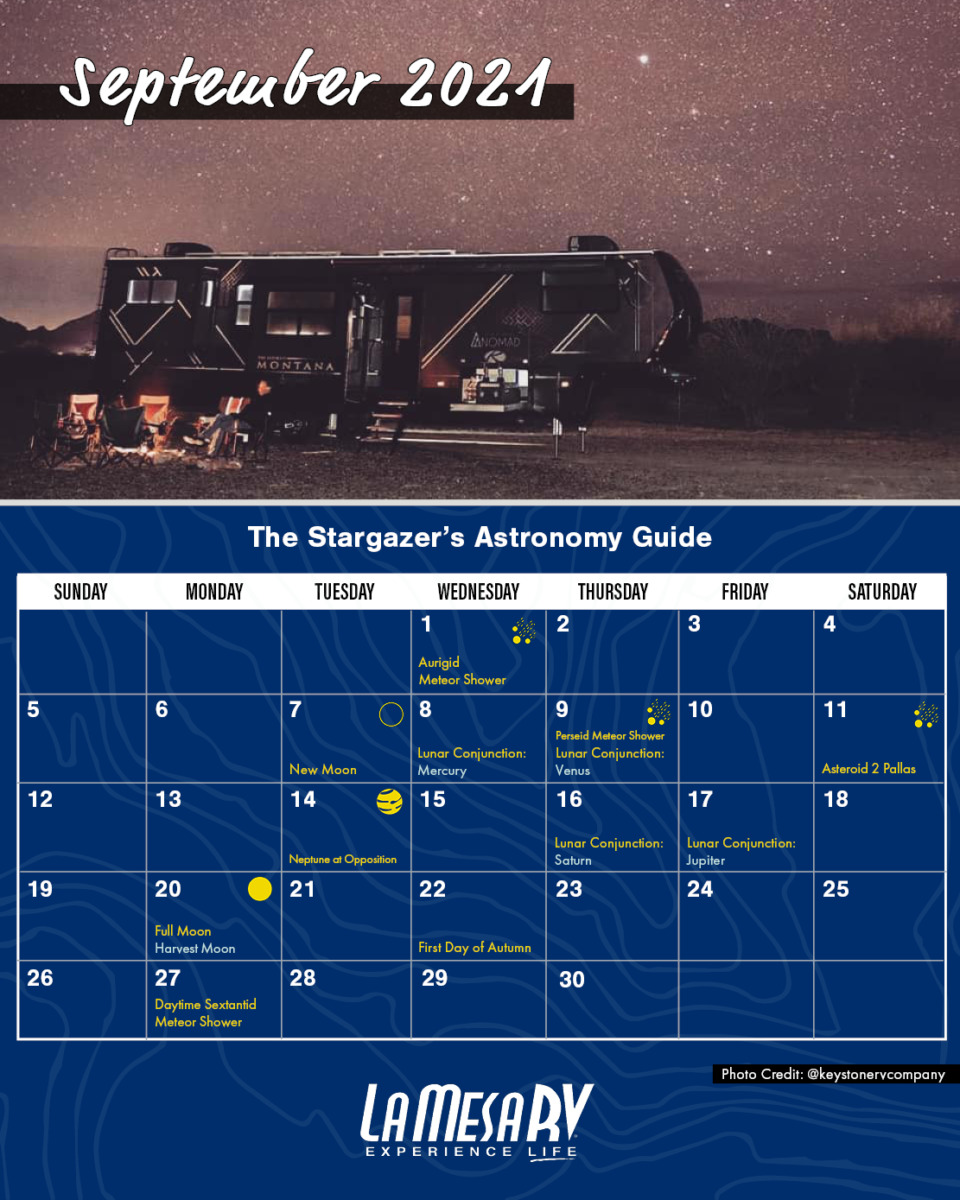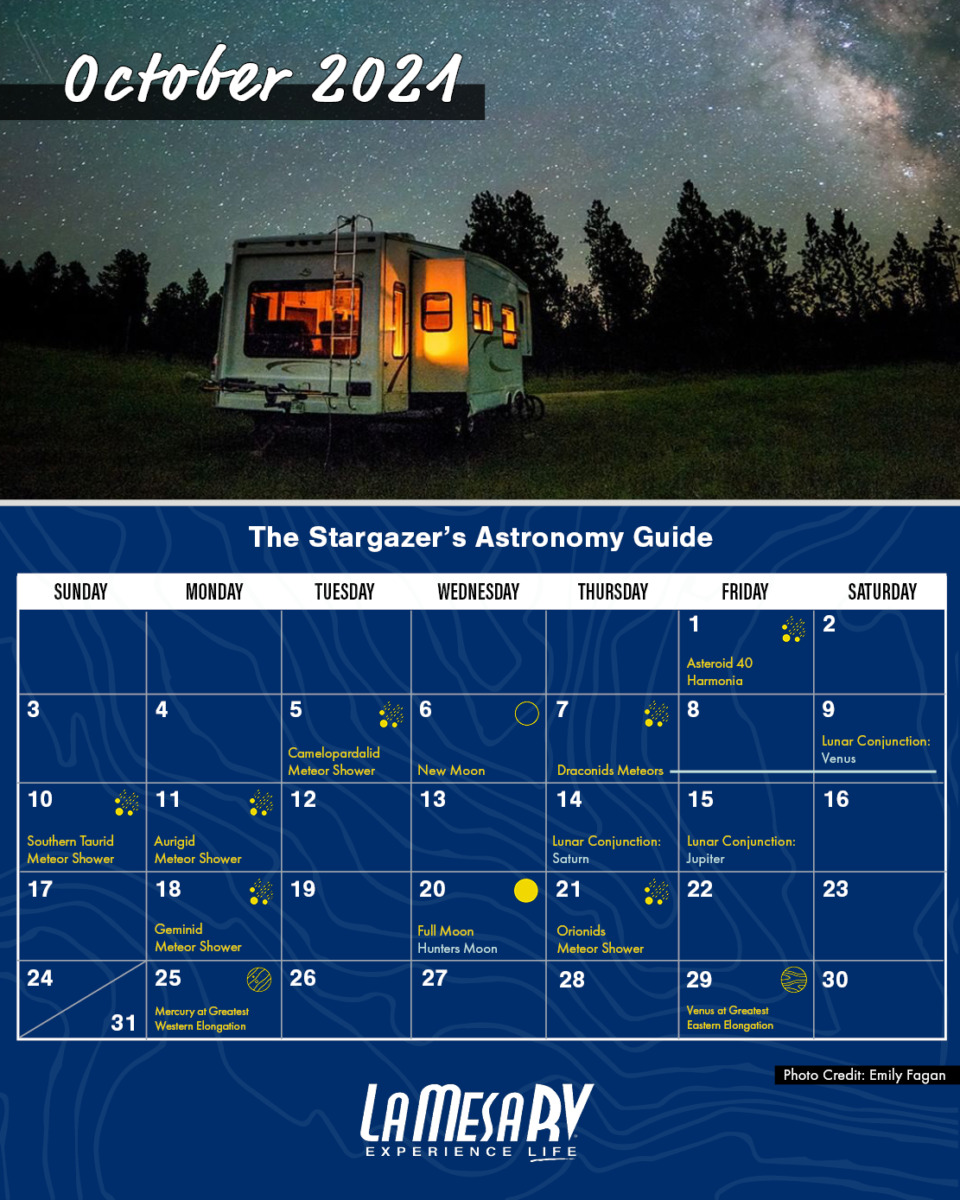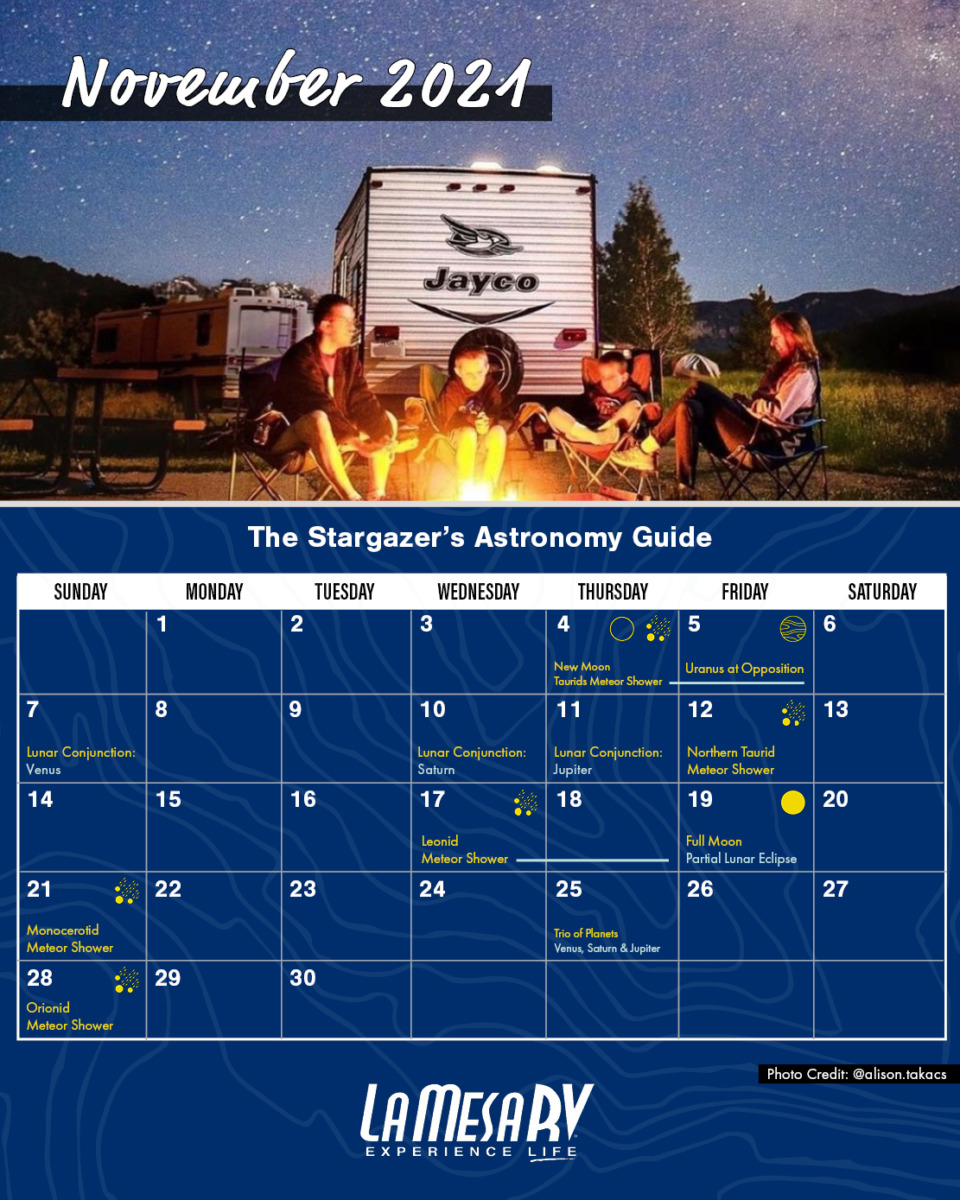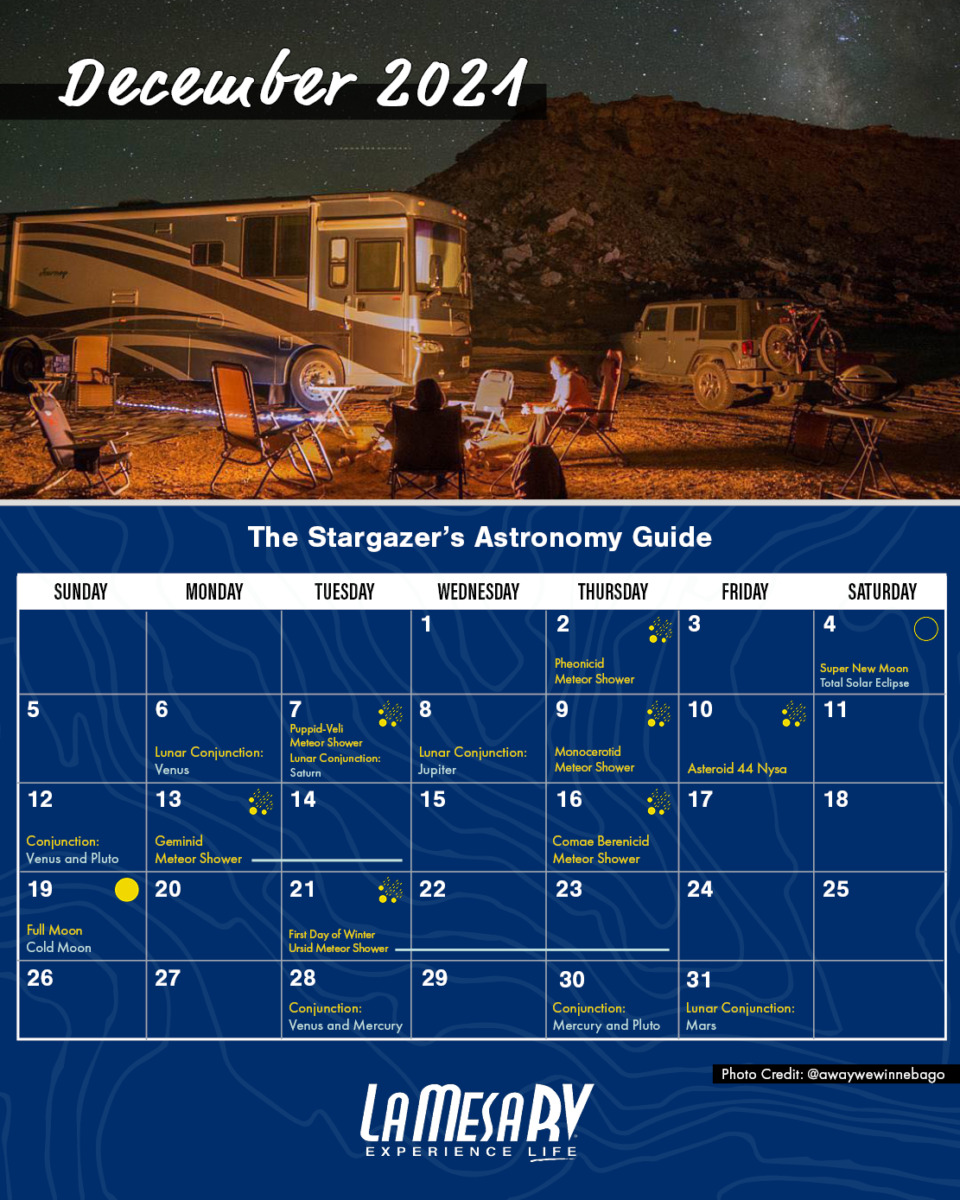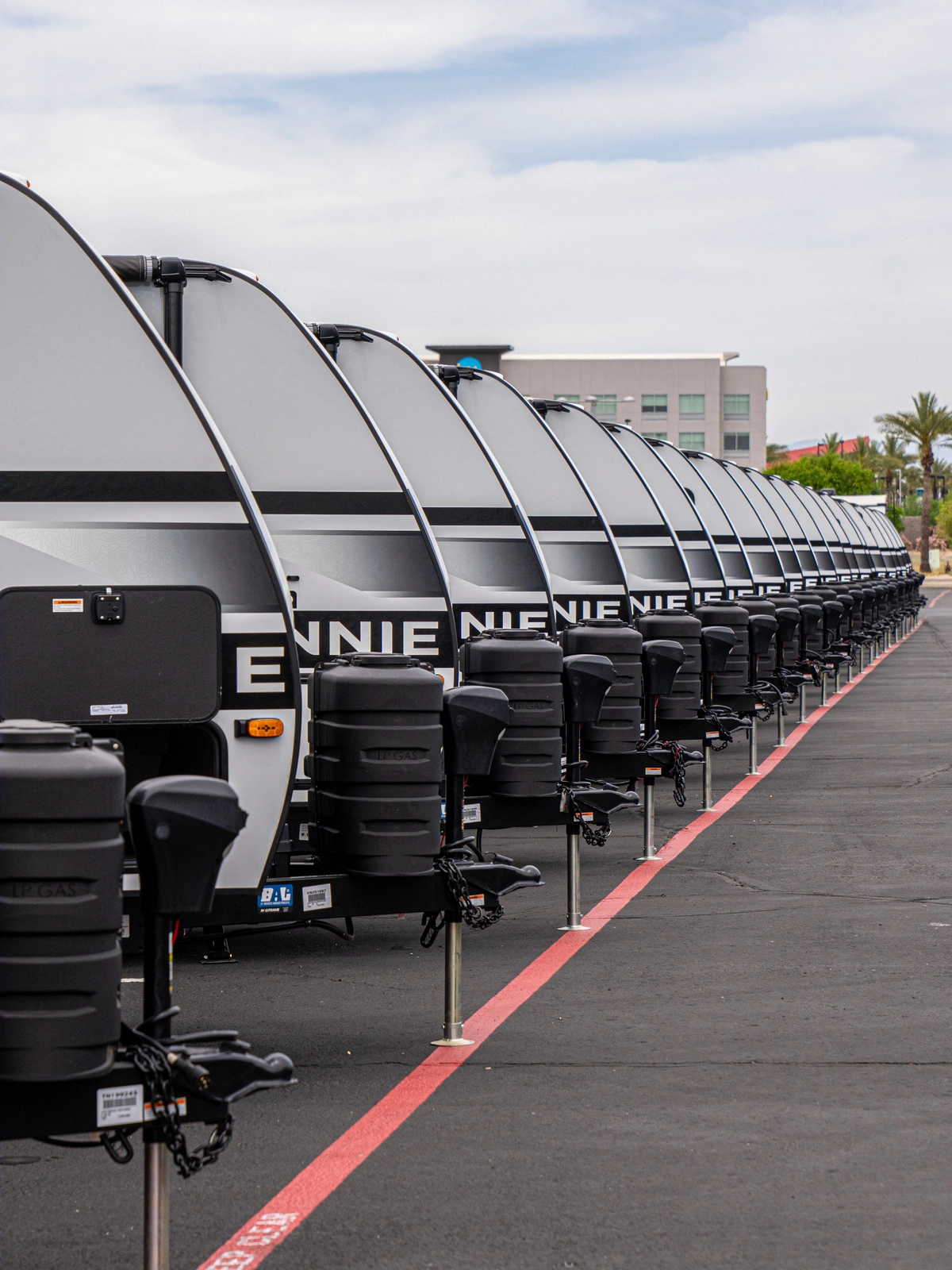Are you in the midst of charting out your 2021 RV adventures? Why not explore skyward? After all, as stargazing enthusiasts know, some of the greatest sights our world has to offer appear after dark! Taking your RV, motorhome, or towable out for an evening of skywatching makes for the perfect remote celestial escape. To help you keep track of the brightest moments to come in 2021, we're bringing you the RVer's complete calendar to astronomical events.
From meteor showers to rare lunar eclipses, read on and download our monthly calendar to start planning your next RV getaway beneath the night skies!
THE RVER'S COMPLETE CALENDAR FOR STARGAZING IN 2021
EVENT KEY:




Located on the opposite side of the earth as the sun, the full moon will be completely illuminated. This phase will occur at 19:18 UTC. While the full moon is always a stunning sight to enjoy with a set of binoculars, the bright lunar illumination can make it difficult for stargazing. Full moon events are best enjoyed during moon rises.
Did You Know? -- Early Native American tribes coined this full moon as the "Wolf Moon" because it marked the time of year when hungry wolf packs howled from a distance.

Asteroid 18 Melpomene will be lying in the constellation Cancer, well above the horizon for much of the night. Regardless of your location, 18 Melpomene will reach its highest point in the sky around midnight local time. Be sure to bring your binoculars for this one!
This meteor shower will be active from January 28 to February 21, producing its peak rate of meteors around the 8th of February. Over this period, there will be a chance of seeing a-Centaurid meteors from anywhere where the shower's radiant point (in the constellation Centaurus) is above the horizon. We recommend using a sky chart app to get your bearings of constellation locations throughout the night. Skyview is an excellent option, available on iOS and Android devices!
Located on the same side of the Earth as the sun, the moon will not be visible in the night sky. With no moonlight to interfere, this makes for the best time to observe faint celestial views, such as galaxies, star clusters, and shooting stars.
A conjunction of Venus and Jupiter will be visible in the eastern sky immediately before sunrise. Venus is the second-closest planet to the sun, and its orbit is inside that of Earth's, so it can be seen only near sunrise or sunset. Those hoping to witness the view will have to rise early and look to the east about a half-hour before sunrise. The pair of planets will barely be scraping above the horizon, meaning a view unobstructed by trees, hills or buildings will be necessary. Jupiter will be placed above and to the left with Venus a touch below and to the right.
Look skyward as the moon and Mars will be well placed in the constellation of Aries and will be visible to the naked eye or through a pair of binoculars. Use the sky chart app Skyview to get your bearings on constellation locations throughout the night.
Skywatchers can witness Asteroid 29 Amphitrite in the constellation Leo, well above the horizon for much of the night. Regardless of your location, the asteroid will reach its highest point in the sky around midnight local time.
Located on the opposite side of the earth as the sun, the full moon will be completely illuminated. This phase will occur at 08:19 UTC. While the full moon is always a stunning sight to enjoy with a set of binoculars, the bright lunar illumination can make it difficult for stargazing. Full moon events are best enjoyed during moon rises.
Did You Know? -- Early Native American tribes coined this full moon as the "Snow Moon" because it marked the time of year when snowfall was at its heaviest peak.

Asteroid 4 Vesta will be lying in the constellation Leo, well above the horizon for much of the night. Regardless of your location, the asteroid will reach its highest point in the sky around midnight local time. Be sure to bring your binoculars for this one!
Before daybreak, this conjunction will be slightly easier to find, as long as there is a clear view of the eastern horizon. About 45 minutes before sunrise, Jupiter and Mercury will appear extremely close. Mercury is often dim and difficult to spot due to its small size and proximity to the sun, but with Jupiter so close, it will not be as difficult to find.
This evening offers the best opportunity to enjoy a bright view of Mercury. The planet will be at its highest point above the horizon in the morning sky. For the best skywatching experience, be sure to look for the planet low in the eastern sky just before sunrise.
This rare and spectacular "quadruple conjunction" will leave a group of planets splayed across the night sky. Look to the southeast around 30 minutes before sunrise, and you'll witness Mercury, Saturn, and Jupiter in a perfect line. All three will be visible with the naked eye in the predawn sky, with Jupiter being the brightest in the middle. The crescent moon will add to the trio, just below and to the right.
Located on the same side of the Earth as the sun, the moon will not be visible in the night sky. With no moonlight to interfere, this makes for the best time to observe faint celestial views, such as galaxies, star clusters, and shooting stars.
This meteor shower will be active from February 25 to March 28, producing its peak rate of meteors around March 14. There will be a chance of seeing g-Normid meteors whenever the shower's radiant point (in the constellation Norma) is above the horizon, with the number of visible meteors increasing the higher the radiant point is in the sky. Use the sky chart app Skyview to get your bearings on constellation locations throughout the night.
The planet Venus reaches its greatest eastern elongation of 46.6 degrees from the Sun. This is the best time to view Venus since it will be at its highest point above the horizon in the morning sky. Look for the bright planet in the eastern sky before sunrise.
A supermoon occurs when the full moon coincides with the closest approach to Earth's orbit. This phenomenon creates the appearance of a brighter and closer moon than normal. Though the difference is difficult to tell with the naked eye, we highly recommend enjoying the view with a pair of binoculars! Keep in mind, the bright lunar illumination can make it difficult for stargazing. Full moon events are best enjoyed during moon rises. Take the little ones on a brightly lit camping trip during this moon phase and of course, don't forget to howl at the moon!
Did You Know? -- Early Native American tribes coined this full moon as the "Worm Moon" because it marked the time of year when the ground would begin to soften and the earthworms would reappear.

This asteroid can be seen lying in the constellation Virgo, well above the horizon for much of the night. Regardless of your location, 9 Metis will reach its highest point in the sky around midnight local time. Binoculars are encouraged for this one!
Look skyward as the moon and Saturn will be well placed in the constellation of Capricornus and will be visible to the naked eye or through a pair of binoculars. Use the sky chart app Skyview to get your bearings on constellation locations throughout the night.
Look skyward as the moon and Jupiter will be well placed in the constellation of Capricornus and will be visible to the naked eye or through a pair of binoculars.
Located on the same side of the Earth as the sun, the moon will not be visible in the night sky. With no moonlight to interfere, this makes for the best time to observe faint celestial views, such as galaxies, star clusters, and shooting stars.
These evenings mark an ideal time to witness earthshine, where the unlit part of the waxing/waning moon becomes visible. This is created by the sun's light reflecting off the Earth's surface and back onto the moon. It is also known as Da Vinci glow after Leonardo who was the first to describe this stunning phenomenon.
Look skyward as the moon and Mars will be well placed in the constellation of Taurus and will be visible to the naked eye or through a pair of binoculars.
A typical meteor shower typically produces 20 meteors per hour at its peak. This shower has been produced by dust particles left by the comet C/1861 G1 Thatcher, first discovered in 1861. Though the glare from the nearly full moon will block out all but the brightest meteors, if you are patient you may still be able to catch a few meteors. Viewing from a dark location after midnight is recommended. Meteors will radiate from the constellation Lyra, but can appear anywhere in the sky.
This meteor shower will be active from April 15 to April 28, producing its peak rate of meteors around April 23. Throughout this period, there will be a chance of seeing the meteor shower whenever the shower's radiant point (in the constellation Puppis) is above the horizon, with the number of visible meteors increasing the higher the radiant point is in the sky.
A supermoon occurs when the full moon coincides with the closest approach to Earth's orbit. This phenomenon creates the appearance of a brighter and closer than normal moon. Though the difference is difficult to tell with the naked eye, we highly recommend enjoying the view with a pair of binoculars! Keep in mind, the bright lunar illumination can make it difficult for stargazing. Full moon events are best enjoyed during moon rises.
Did You Know? -- Early Native American tribes coined this full moon as the "Full Pink Moon" because it marked the appearance of Moss Pink Flora (wild ground phlox), one of the first spring flowers of the season.

Look skyward as the moon and Saturn will be well placed in the constellation of Capricornus and will be visible to the naked eye or through a pair of binoculars. Use the sky chart app Skyview to get your bearings on constellation locations throughout the night.
Look skyward as the moon and Jupiter will be well placed in the constellation of Aquarius and will be visible to the naked eye or through a pair of binoculars.
An above-average meteor shower, the ETA Aquarids can produce up to 60 meteors per hour at its peak. Most activity can be seen in the southern hemisphere. In the northern hemisphere, the meteor rate can reach up to 30 per hour. This meteor shower is produced by the dust particles left behind by the comet Halley, which has been observed since ancient times. This shower runs annually from April 19 to May 28, peaking this year on the night of May 6th and the morning of May 7. Keep in mind, the nearly full moon may make it difficult to catch meteors, so binoculars are highly recommended. Meteors will radiate from the constellation Aquarius but can appear anywhere in the sky. Be sure to set up in a dark location (avoid light pollution) after midnight. Patient stargazers will still have a chance to catch some of the brightest meteors as they fall from the skies.
These evenings mark an ideal time to witness earthshine, where the unlit part of the waxing/waning moon becomes visible. This is created by the sun's light reflecting off the Earth's surface and back onto the moon. It is also known as Da Vinci glow after Leonardo who was the first to describe this stunning phenomenon.
Located on the same side of the Earth as the sun, the moon will not be visible in the night sky. With no moonlight to interfere, this makes for the best time to observe faint celestial views, such as galaxies, star clusters, and shooting stars.
Look skyward as the moon and Mars will be well placed in the constellation of Gemini and will be visible to the naked eye or through a pair of binoculars.
This is a great night to observe Mercury at its highest point above the horizon in the evening sky. Look for the planet low in the western sky just after sunset. Don't forget your binoculars!
A supermoon occurs when the full moon coincides with the closest approach to Earth's orbit. This phenomenon creates the appearance of a brighter and closer moon than normal. Though the difference is difficult to tell with the naked eye, we highly recommend enjoying the view with a pair of binoculars! Keep in mind, the bright lunar illumination can make it difficult for stargazing. Full moon events are best enjoyed during moon rises.
A total lunar eclipse occurs when the moon passes completely through the Earth's dark shadow. During this phenomenon, the moon will gradually get darker and then take on a rust or blood red color. This change in color is actually caused by the atmosphere of the Earth. In the Eastern United States, the early morning eclipse reaches totality as the moon dips below the horizon, with places as far west as the Missouri River witnessing only a partial eclipse. Houston and Dallas will be able to watch the eclipse reach a rust totality at moonset, just before sunrise. In the Intermountain West and along the West Coast, the full extent of totality will be visible, weather permitting. The lunar eclipse's total phase will last approximately 14 minutes.
Venus and Mercury will share the same right ascension, both in the constellation Taurus. The planets will be close enough to fit within the field of view of a telescope, but will also be visible through a pair of binoculars.
Did You Know? -- Early Native American tribes coined this full moon as the "Flower Moon" because it marked the time of year in that Spring flowers bloom in abundance.

Look skyward as the moon and Jupiter will be well placed in the constellation of Aquarius and will be visible to the naked eye or through a pair of binoculars.
This asteroid will be well placed, lying in the constellation Scorpius, well above the horizon for much of the night. Regardless of your location, 63 Ausonia will reach its highest point in the sky around midnight local time.
Located on the same side of the Earth as the sun, the moon will not be visible in the night sky. With no moonlight to interfere, this makes for the best time to observe faint celestial views, such as galaxies, star clusters, and shooting stars.
An annular solar eclipse occurs when the moon is too far away from the Earth to completely cover the sun. This results in a ring of light around the darkened moon. For the northeastern U.S. and eastern Canada, this will be a brief partial solar eclipse, but for a small region of northern Ontario and far northern Quebec, a 'ring of fire' solar eclipse will be visible. Bring proper eyewear for this event! Looking at the sun without a specially-made solar filter can lead to permanent eye damage.
Look skyward as the moon and Venus will be well placed in the constellation of Gemini and will be visible to the naked eye or through a pair of binoculars.
Look skyward as the moon and Mars will be well placed in the constellation of Cancer and will be visible to the naked eye or through a pair of binoculars.
A supermoon occurs when the full moon coincides with the closest approach to Earth's orbit. This phenomenon creates the appearance of a brighter and closer moon than normal. Though the difference is difficult to tell with the naked eye, we highly recommend enjoying the view with a pair of binoculars! Keep in mind, the bright lunar illumination can make it difficult for stargazing. Full moon events are best enjoyed during moon rises.
Look skyward as the moon and Saturn will be well placed in the constellation of Capricornus and will be visible to the naked eye or through a pair of binoculars.
Look skyward as the moon and Jupiter will be well placed in the constellation of Aquarius and will be visible to the naked eye or through a pair of binoculars.
Did You Know? -- Early Native American tribes coined this full moon as the "Full Strawberry Moon" because it marked the time of year to gather ripening fruit. It also coincides with the peak of the strawberry harvesting season. This moon is also known as the Full Rose Moon and the Full Honey Moon.

This evening offers the best opportunity to enjoy a bright view of Mercury. The planet will be at its highest point above the horizon in the morning sky. For the best skywatching experience, be sure to look for the planet low in the eastern sky just before sunrise.
Look skyward as the moon and Mercury will be well placed in the constellation of Taurus and will be visible to the naked eye or through a pair of binoculars.
Located on the same side of the Earth as the sun, the moon will not be visible in the night sky. With no moonlight to interfere, this makes for the best time to observe faint celestial views, such as galaxies, star clusters, and shooting stars.
Look skyward as the moon, Mars, and Venus will be well placed in the constellation of Leo and will be visible to the naked eye or through a pair of binoculars.
Venus and Mars will share the same right ascension, both in the constellation Leo. The planets will be close enough to fit within the field of view of a telescope, but will also be visible through a pair of binoculars.
The Moon will be located on the opposite side of the Earth as the Sun and its face will be fully illuminated. This phase occurs at 02:37 UTC. While the full moon is always a stunning sight to enjoy with a set of binoculars, the bright lunar illumination can make it difficult for stargazing. Full moon events are best enjoyed during moon rises.
Look skyward as the moon and Jupiter will be well placed in the constellation of Aquarius and will be visible to the naked eye or through a pair of binoculars.
This meteor shower can produce up to 20 meteors per hour at its peak. It is produced by debris left behind by comets Marsden and Kracht. The shower runs annually from July 12 to August 23. It peaks this year on the night of July 28 and the morning of July 29. The glare from the nearly full moon will make it difficult to catch most of the faintest meteors. Be patient! You should still be able to catch a few bright ones through the peak period. The shower is best viewed from a dark location after midnight. Meteors will radiate from the constellation Aquarius but can appear anywhere in the sky.
The Piscis Austrinid meteor shower will be active from 15 July to 10 August, producing its peak rate of meteors around 28 July. Over this period, there will be a chance of seeing Piscis Austrinid meteors whenever the shower's radiant point (in the constellation Piscis Austrinus) is above the horizon, with the number of visible meteors increasing the higher the radiant point is in the sky. Be sure to bring your binoculars for this one!
The a-Capricornid meteor shower will be active from July 3 to August 15, producing its peak rate of meteors around 30 July. There will be a chance of seeing meteors whenever the shower's radiant point (in the constellation Capricornus) is above the horizon. We recommend using a sky chart app to get your bearings of constellation locations throughout the night. Skyview is an excellent option, available on iOS and Android devices!
Did You Know? -- Early Native American tribes coined this full moon as the "Buck Moon" because it marked the time of year that the male buck deer would begin to grow new antlers. This moon is also known as the Full Thunder Moon and the Full Hay Moon.

Saturn will be at its closest approach to Earth and its face will be fully illuminated by the sun. It will be brighter than any other time of the year and will be visible all night long. This is the best time to view and photograph the planet and its moons. Binoculars are highly recommended! Though a telescope will allow you to see Saturn's rings and a few of its brightest moons.
Located on the same side of the Earth as the sun, the moon will not be visible in the night sky. With no moonlight to interfere, this makes for the best time to observe faint celestial views, such as galaxies, star clusters, and shooting stars.
This meteor shower will be active from July 17 to August 24, producing its peak rate of meteors around August 12. There will be a chance of seeing meteors whenever the shower's radiant point (in the constellation Perseus) is above the horizon, with the number of visible meteors increasing the higher the radiant point is in the sky.
Mercury and Mars will share the same right ascension, both in the constellation Leo. The planets will be close enough to fit within the field of view of a telescope, but will also be visible through a pair of binoculars.
This meteor shower will be active from August 3 to August 25, producing its peak rate of meteors around August 18. There will be a chance of seeing the meteors whenever the shower's radiant point (in the constellation Draco) is above the horizon, with the number of visible meteors increasing the higher the radiant point is in the sky.
Jupiter at its closest approach to Earth and its face will be fully illuminated by the Sun. It will be brighter than any other time of the year and will be visible all night long. This is the best time to view and photograph the planet and its moons. Though a telescope should be able to show you some of the details in the planet's cloud bands. Binoculars should allow you to see Jupiter's four largest moons, appearing as bright dots on either side of the planet.
Look skyward as the moon and Saturn will be well placed in the constellation of Capricornus and will be visible to the naked eye or through a pair of binoculars.
Look skyward as the moon and Jupiter will be well placed in the constellation of Capricornus and will be visible to the naked eye or through a pair of binoculars.
The moon will be located on the opposite side of the Earth as the sun and its face will be fully illuminated. This phase occurs at 12:02 UTC, While the full moon is always a stunning sight to enjoy with a set of binoculars, the bright lunar illumination can make it difficult for stargazing. Full moon events are best enjoyed during moon rises. This full moon will also be a 'Blue Moon'. This rare event only happens once every few years, giving rise to the term, "once in a blue moon." There are normally only three full moons in each season of the year. But since full moons occur every 29.53 days, sometimes a season will contain 4 full moons. Blue moons occur on average once every 2.7 years.
This asteroid can be seen in the constellation Aquarius, well above the horizon for much of the night. Regardless of your location, 89 Julia will reach its highest point in the sky around midnight local time. Be sure to bring your binoculars for this one!
This meteor shower will be active from August 28 to September 5, producing its peak rate of meteors around September 1st. There will be a chance of seeing meteors whenever the shower's radiant point (in the constellation Auriga) is above the horizon, with the number of visible meteors increasing the higher the radiant point is in the sky.
Did You Know? -- Early Native American tribes coined this full moon as the "Sturgeon Moon" because it marked the time of year that the large sturgeon fish of the Great Lakes and other major lakes are more easily caught.

This meteor shower will be active from August 28 to September 5, producing its peak rate of meteors around September 1st. There will be a chance of seeing meteors whenever the shower's radiant point (in the constellation Auriga) is above the horizon, with the number of visible meteors increasing the higher the radiant point is in the sky.
Located on the same side of the Earth as the sun, the moon will not be visible in the night sky. With no moonlight to interfere, this makes for the best time to observe faint celestial views, such as galaxies, star clusters, and shooting stars.
Look skyward as the moon and Mercury will be well placed in the constellation of Virgo and will be visible to the naked eye or through a pair of binoculars.
This meteor shower will be active from September 5 to September 21, producing its peak rate of meteors around September 9th. There will be a chance of seeing some meteors whenever the shower's radiant point (in the constellation Perseus) is above the horizon, with the number of visible meteors increasing the higher the radiant point is in the sky.
Look skyward as the moon and Venus will be well placed in the constellation of Virgo and will be visible to the naked eye or through a pair of binoculars.
This asteroid will be lying in the constellation Pisces, well above the horizon for much of the night. Regardless of your location, 2 Pallas will reach its highest point in the sky around midnight local time.
Neptune will be at its closest approach to Earth and its face will be fully illuminated by the Sun. It will be brighter than any other time of the year and will be visible all night long. This is the best time to view and photograph Neptune. Due to its extreme distance from Earth, it will only appear as a tiny blue dot in all but the most powerful telescopes. This is a great opportunity to explore a local observatory for the chance to witness the 'blue giant planet'.
This is the best time to view Mercury since it will be at its highest point above the horizon in the evening sky. Look for the planet low in the western sky just after sunset.
Look skyward as the moon and Saturn will be well placed in the constellation of Capricornus and will be visible to the naked eye or through a pair of binoculars.
Look skyward as the moon and Jupiter will be well placed in the constellation of Capricornus and will be visible to the naked eye or through a pair of binoculars.
The Moon will be located on the opposite side of the Earth as the Sun and its face will be fully illuminated. This phase occurs at 23:54 UTC. While the full moon is always a stunning sight to enjoy with a set of binoculars, the bright lunar illumination can make it difficult for stargazing. Full moon events are best enjoyed during moon rises.
The Daytime Sextantid meteor shower will be active from September 9 to October 9, producing its peak rate of meteors around September 27th. There will be a chance of seeing Daytime Sextantid meteors whenever the shower's radiant point (in the constellation Sextans) is above the horizon, with the number of visible meteors increasing the higher the radiant point is in the sky. We recommend using a sky chart app to get your bearings of constellation locations throughout the night. Skyview is an excellent option, available on iOS and Android devices!
Did You Know? -- Early Native American tribes coined this full moon as the "Harvest Moon" because it marked the time of year that corn was harvested around this time of year.

This asteroid will be lying in the constellation Cetus, well above the horizon for much of the night. Regardless of your location, 40 Harmonia will reach its highest point in the sky around midnight local time. Be sure to bring your binoculars for this one!
This meteor shower will be active Oct 5-Oct 6, producing its peak rate of meteors on October 5th. There will be a chance of catching meteors whenever the shower's radiant point (in the constellation Draco) is above the horizon, with the number of visible meteors increasing the higher the radiant point is in the sky. We recommend using a sky chart app to get your bearings of constellation locations throughout the night. Skyview is an excellent option, available on iOS and Android devices!
Located on the same side of the Earth as the sun, the moon will not be visible in the night sky. With no moonlight to interfere, this makes for the best time to observe faint celestial views, such as galaxies, star clusters, and shooting stars.
This is a minor meteor shower producing about 10 meteors per hour. It is produced by dust grains left behind by comet 21P Giacobini-Zinner, first discovered in 1900. Best viewing will be in the early evening instead of early morning like most other showers. The shower runs annually from Oct 6-10 and peaks this year on the night of the 7th. This year, the nearly new moon will leave dark skies for a stunning, low light view. Be sure to observe from a dark location far away from city lights. Meteors will radiate from the constellation Draco but can appear anywhere in the sky.
Look skyward as the moon and Venus will be well placed in the constellation of Scorpius and will be visible to the naked eye or through a pair of binoculars.
This meteor shower will be active from September 10 to November 20, producing its peak rate of meteors around October 10th. There will be a chance of seeing some meteors whenever the shower's radiant point (in the constellation Cetus) is above the horizon, with the number of visible meteors increasing the higher the radiant point is in the sky.
This meteor shower will be active Oct 10-Oct 18, producing its peak rate of meteors around October 11th. There will be a chance of witnessing meteors whenever the shower's radiant point (in the constellation Auriga) is above the horizon, with the number of visible meteors increasing the higher the radiant point is in the sky.
Look skyward as the moon and Saturn will be well placed in the constellation of Capricornus and will be visible to the naked eye or through a pair of binoculars.
Look skyward as the moon and Jupiter will be well placed in the constellation of Capricornus and will be visible to the naked eye or through a pair of binoculars.
This meteor shower will be active Oct 14-Oct 27, producing its peak rate of meteors around October 18th. There will be a chance of witnessing meteors whenever the shower's radiant point (in the constellation Gemini) is above the horizon, with the number of visible meteors increasing the higher the radiant point is in the sky.
The Moon will be located on the opposite side of the Earth as the Sun and its face will be fully illuminated. This phase occurs at 14:57 UTC. While the full moon is always a stunning sight to enjoy with a set of binoculars, the bright lunar illumination can make it difficult for stargazing. Full moon events are best enjoyed during moon rises.
This meteor shower will produce up to 20 meteors per hour at its peak. It is produced by dust grains left behind by comet Halley, known and observed since ancient times. The shower runs annually from Oct 2-Nov 7. It peaks this year on the night of October 21st and the morning of October 22nd. Although the glare from the full moon will block out all but the brightest meteors, if you are patient, you should still be able to witness a few good meteors. Be sure to watch from a dark location after midnight. Meteors will radiate from the constellation Orion, but can appear anywhere in the sky.
This is the best time to view Mercury since it will be at its highest point above the horizon in the morning sky. Look for the planet low in the eastern sky just before sunrise.
This is the best time to view Venus since it will be at its highest point above the horizon in the evening sky. Look for the bright planet in the western sky after sunset.
Did You Know? -- Early Native American tribes coined this full moon as the "Hunters Moon" because it marks the time of year that the leaves are falling and the game is fat and ready to hunt.

Located on the same side of the Earth as the sun, the moon will not be visible in the night sky. With no moonlight to interfere, this makes for the best time to observe faint celestial views, such as galaxies, star clusters, and shooting stars.
The Taurids produces about 5-10 meteors per hour. Consisting of two separate streams, the first is produced by dust grains left behind by Asteroid 2004 TG10, the second by debris left behind by Comet 2P Encke. The shower runs from September 7 to December 10. It peaks this year on the night of November 4th. The new moon will leave dark skies this year for great viewing. Meteors will radiate from the constellation Taurus, but can appear anywhere in the sky.
Uranus will be at its closest approach to Earth and its face will be fully illuminated by the Sun. It will be brighter than any other time of the year and will be visible all night long. This will be the best time for observation. Due to its distance, it will only appear as a tiny blue-green dot in all but the most powerful telescopes. This is a great opportunity to explore a local observatory for the chance to witness the planet from afar!
Look skyward as the moon and Venus will be well placed in the constellation of Sagittarius and will be visible to the naked eye or through a pair of binoculars.
Look skyward as the moon and Saturn will be well placed in the constellation of Capricornus and will be visible to the naked eye or through a pair of binoculars.
Look skyward as the moon and Jupiter will be well placed in the constellation of Capricornus and will be visible to the naked eye or through a pair of binoculars.
This meteor shower will be active from October 20 to December 10, reaching its peak rate of meteors on Nov 12th. There will be a chance of witnessing meteors whenever the shower's radiant point (in the constellation Taurus) is above the horizon.
The Leonids shower yields up to 15 meteors per hour at its peak. The Leonids meteor shower is produced by dust grains left behind by comet Tempel-Tuttle, discovered in 1865. The shower runs from November 6-30, peaking on the night of the 17th and morning of the 18th. Although the brightness of the nearly full moon will make it difficult to catch most average meteors, if you are patient, you should still be able to catch a few bright ones. Meteors will radiate from the constellation Leo but can appear anywhere in the sky.
The Moon will be located on the opposite side of the Earth as the Sun and its face will be fully illuminated. This phase occurs at 08:59 UTC. While the full moon is always a stunning sight to enjoy with a set of binoculars, the bright lunar illumination can make it difficult for stargazing. Full moon events are best enjoyed during moon rises.
This partial eclipse will be very close to a total lunar eclipse with just a sliver of the moon missing Earth's dark inner shadow. The moon may briefly appear rusty orange or red, similar to what occurs during the height of a total eclipse. The eclipse will be visible throughout most of eastern Russia, Japan, the Pacific Ocean, North America, Mexico, Central America, and parts of western South America. For those located on the eastern half of Canada and the U.S., this may yield a more impressive experience than that of the full lunar eclipse in May.
This meteor shower will be active through Nov 15-25, with its peak rate of meteors around November 21st. You will be able to catch meteors whenever the shower's radiant point (in the constellation Canis Minor) is above the horizon, with the number of visible meteors increasing the higher the radiant point is in the sky.
Venus, Saturn, and Jupiter will be lined up just after sunset on with all three outshining every surrounding star in the sky. This is not just a single-night event, so if cloudy weather yields difficult viewing conditions, skywatchers can look for the three planets each evening into the start of December.
This meteor shower will be active from November 13 through December 6, producing its peak rate of meteors around November 28th. There will be a chance of seeing meteors whenever the shower's radiant point (in the constellation Orion) is above the horizon, with the number of visible meteors increasing the higher the radiant point is in the sky.
Did You Know? -- Early Native American tribes coined this full moon as the "Beaver Moon" because it marks the time of year to set the beaver traps before the swamps and rivers froze.

This meteor shower will be active from November 28 through December 9, with its peak rate of meteors appearing around December 2nd. There will be a chance of seeing meteors whenever the shower's radiant point (in the constellation Phoenix) is above the horizon, with the number of visible meteors increasing the higher the radiant point is in the sky.
Located on the same side of the Earth as the sun, the moon will not be visible in the night sky. With no moonlight to interfere, this makes for the best time to observe faint celestial views, such as galaxies, star clusters, and shooting stars. A total solar eclipse will also take place. The moon will completely block the Sun, revealing the Sun's stunning outer atmosphere known as the corona. The path of totality will for this eclipse be limited to Antarctica and the southern Atlantic Ocean.
Look skyward as the moon and Venus will be well placed in the constellation of Sagittarius and will be visible to the naked eye or through a pair of binoculars.
This meteor shower will be active from Dec 1-15, producing its peak rate of meteors around December 7th. There will be a chance of seeing meteors whenever the shower's radiant point (in the constellation Vela) is above the horizon, with the number of visible meteors increasing the higher the radiant point is in the sky.
Look skyward as the moon and Saturn will be well placed in the constellation of Capricornus and will be visible to the naked eye or through a pair of binoculars.
Look skyward as the moon and Jupiter will be well placed in the constellation of Capricornus and will be visible to the naked eye or through a pair of binoculars.
This meteor shower will be active from Dec 9-20, producing its peak rate of meteors around December 9th. There will be a chance of seeing meteors whenever the shower's radiant point (in the constellation Monoceros) is above the horizon, with the number of visible meteors increasing the higher the radiant point is in the sky.
This asteroid will be lying in the constellation Taurus, well above the horizon for much of the night. Regardless of your location, 44 Nysa will reach its highest point in the sky around midnight local time.
Venus and Pluto will share the same right ascension, both in the constellation Sagittarius. The planets will be close enough to fit within the field of view of a telescope, but will also be visible through a pair of binoculars.
This the king of the meteor showers. It is considered by many to be the best shower in the heavens, yielding up to 120 multicolored meteors per hour at its peak, produced by debris left behind by an asteroid known as 3200 Phaethon, discovered in 1982. This annual shower runs from December 7-17. It peaks this year on the night of the 13th and the morning of the 14th. Though the light of the waxing gibbous moon may make for difficult viewing of the fainter meteors, the Geminids are so numerous and bright that you will still be able to catch several bright ones. Meteors will radiate from the constellation Gemini but can appear anywhere in the sky.
This meteor shower will be active from Dec 12-23, producing its peak rate of meteors around December 16th. There will be a chance of seeing meteors whenever the shower's radiant point (in the constellation Leo) is above the horizon, with the number of visible meteors increasing the higher the radiant point is in the sky.
The Moon will be located on the opposite side of the Earth as the Sun and its face will be fully illuminated. This phase occurs at 04:37 UTC. While the full moon is always a stunning sight to enjoy with a set of binoculars, the bright lunar illumination can make it difficult for stargazing. Full moon events are best enjoyed during moon rises.
This will be a minor meteor shower yielding about 5-10 meteors per hour. It is produced by dust grains left behind by comet Tuttle, first discovered in 1790. The shower will run annually from December 17-25. It peaks this year on the night of the 21st and morning of the 22nd. Although the glare from the nearly full moon will block out all but the brightest meteors, if you are patient, you should still be able to witness a few good meteors. Be sure to watch from a dark location after midnight. Meteors will radiate from the constellation Ursa Minor but can appear anywhere in the sky.
Venus and Mercury will share the same right ascension, both in the constellation Sagittarius. Be sure to bring your binoculars for this one!
Mercury and Mars will share the same right ascension, both in the constellation Sagittarius. The planets will be close enough to fit within the field of view of a telescope, but will also be visible through a pair of binoculars.
Look skyward as the moon and Mars will be well placed in the constellation of Capricornus and will be visible to the naked eye or through a pair of binoculars.
Did You Know? -- Early Native American tribes coined this full moon as the "Cold Moon" because it marks the time of year when the cold winter air settles in and the nights become long and dark.
Are you new to the ins and outs of skywatching? Check out our RVer's Introductory Guide to Stargazing with REI for master tips and tricks to making the most out of your RV adventures beneath the stars!
RV Under the Stars 2021: The RVer's Complete Stargazing Calendar
Jan 25, 2021 | 68 min read